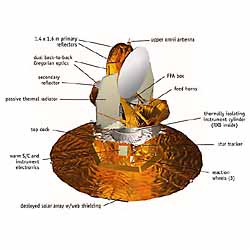
WMAP Observatory Overview
The Wilkinson Microwave Anisotropy Probe (WMAP) is named after Dr. David Wilkinson, a member of the science team and pioneer in the study of cosmic background radiation. The science goals of the WMAP broadly dictate that the relative Cosmic Microwave Background (CMB) temperature be measured accurately over the full sky with high angular resolution and sensitivity. The overriding priority in the design was the need to control systematic errors in the final maps. The specific goal of WMAP is to map the relative CMB temperature over the full sky with an angular resolution of at least 0.3°, a sensitivity of 20 µK per 0.3° square pixel, with systematic artifacts limited to 5 µK per pixel.
To achieve these goals, WMAP uses differential microwave radiometers that measure temperature differences between two points on the sky. WMAP observes the sky from an orbit about the L2 Sun-Earth Lagrange point, 1.5 million km from Earth. This vantage point offers an exceptionally stable environment for observing since the observatory can always point away from the Sun, Earth and Moon while maintaining an unobstructed view to deep space. WMAP scans the sky in such a way as to cover ~30% of the sky each day and as the L2 point follows the Earth around the Sun WMAP observes the full sky every six months. To facilitate rejection of foreground signals from our own Galaxy, WMAP uses five separate frequency bands from 22 to 90 GHz.
WMAP Spacecraft Overview:
The main features of the WMAP spacecraft are shown in the following collection of diagrams and photographs. The most prominent feature is a pair of back-to-back telescopes that focus the microwave radiation from two spots on the sky roughly 140� apart and feed it to 10 separate differential receivers that sit in an assembly directly underneath the optics. Large "elephant ear" radiators provide cooling for the sensitive amplifiers in the receiver assembly. The bottom half of the spacecraft provides the services necessary to carry out the mission including command and data collection electronics, attitude (pointing) control and determination, power services and a hydrazine propulsion system. The entire observatory is kept in continuous shade by a large deployable sun shield that also supports the solar panels.

